Dear Artist,
Yesterday, Rich Woy of Ocala, Florida asked, “How do you know when a painting is overworked? Are there boundaries or clues? Is this judgment left to the artist or the critic?”
Thanks, Rich. Good question. Funnily, at dinner last night a subscriber happened to mention that I habitually overworked the word “overworked.” I had to explain myself.
For sure, it’s a term among artists. “Too many notes,” said the Emperor-composer Joseph II to Wolfgang Amadeus Mozart. Similar thing comes up in painting. Too many strokes. Having said that, you have to know that tight photo-realism is not necessarily overworked. A close-up look at evolved realism can show understated brushwork and strokes in appropriate places. Overworked mainly applies to expressive, impressionist and broad-treatment works where freshness and surface quality are denied.
Overworking takes place when you lose control. As you fail in facility and freshness, you try to save the day with fiddle and fuss. The passage looks laboured.
Overworking happens when you’re overtired, distracted, suffering from desire deficit, and particularly when you’re not paying enough attention to reference material or personal creative vision. More crudely, it happens when you don’t know what you’re doing. The clue comes when you see you’ve gone too far. Work doesn’t look as good as it might. “A painting,” says Harley Brown, “is always finished before the artist thinks it is.”
While the general public may not be so sensitive to overworking, and sophisticated critics may be looking at other criteria, to the actively creative eye, overworking is easily spotted and often spoils the look of otherwise fine work. Artists have ruses, however. The bad areas can sometimes be obfuscated by nearby passages of bravura or other visual distractions, but smoke and mirrors doesn’t always hide the true measure of the artist. The main antidote is to scrape off and start over.
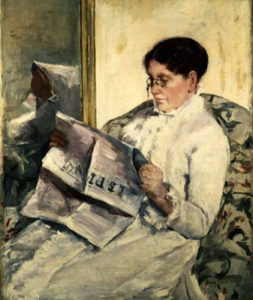
Reading “Le Figaro” (Portrait of the artist’s mother), 1878
Oil on canvas
104 x 83.7 cm
by Mary Cassatt
The overwork boundary often lies in the grey zone between the intuitive mode and controlled rendering. The fine art is in watching yourself in the act of intuiting. As Ted Smuskiewicz says, “You learn to leave your strokes alone.”
Best regards,
Robert
PS: “Great is the art of beginning, but greater is the art of ending.” (Henry Wadsworth Longfellow)
Esoterica: The most powerful antidote to overworking is a habitual, timely pause. Work periods need to be laced with both brief and long ones. Lean back, stand back, walk around, move the work to another easel. In my much-celebrated case of Attention Deficit Disorder, long pauses are difficult, so I work on more than one at a time. As Quebec plein air painter Sylvio Gagnon says, “The best way to finish a painting is to start a new one.” In any case, you need to neutralize indecision. “When you’ve just done it, you’re not sure. But when you’ve sat with it for a couple of hours and you don’t want to do anything more to it, that’s a great feeling.” (Damien Hirst)
This letter was originally published as “Overworked” on May 13, 2008.
Have you considered a Premium Artist Listing? With each letter, an artist is featured at the bottom of this page. The Premium Artist Listings are a means of connecting artist subscribers through their work. Proceeds from each listing contribute to the production of The Painter’s Keys.
“We only have our nervous system to paint.” (Francis Bacon)
Featured Workshop
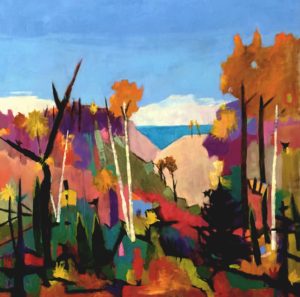 Permission to Paint Expressively Series Session 1
Permission to Paint Expressively Series Session 1
June 27-30, 2022
Join Ellie Harold for “Expressive Painting: Color from the Inside Out.” Do you struggle with color? For chromophobics or anyone who would like greater freedom in their use of color, this workshop focuses on activating and applying your innate color sense. Content, process and lightly structured exercises allow you access to a wider range of color expression in the safe space of Ellie’s studio, located only 3 blocks from Lake Michigan near Sleeping Bear Dunes. “Expressive Painting: Color from the Inside Out” has the potential to transform not only your art but your life! Details and registration at www.EllieHarold.com.
Featured Artist
Los Angeles-based artist Lisa Chakrabarti works in a variety of media: oils, acrylics, pastels, watercolors, graphite and colored pencils. Focusing on a style she calls “romantic naturalism” – impressionism based largely on subjects in the natural world – her works have found their way into galleries in Los Angeles, Florida, Colorado and New York. In 1995, after being introduced to sumi-e and Chinese ink painting by Asian friends, Lisa became captivated by the apparent freedom and subtlety of this ancient medium. This shift in focus has informed her work ever since.

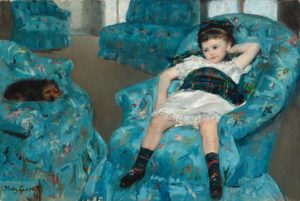
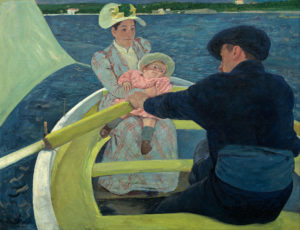
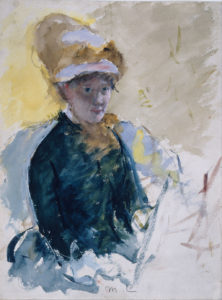
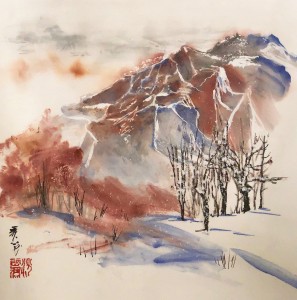



11 Comments
Desire deficit? I love it! :)
I have a painting I started several years ago. We were planning to move. I had to move this painting which is about 3’x 5′ out of my studio and temporarily hang it in our guest room.
That was 3 years ago. Our house was not sold and the 3/4 finished painting is still there in the bedroom.
When in my studio I’d work on it.
The thing is our guests assume it is done. Not sure if that is a good thing.
I ‘paint’ with fibre and thread on my sewing machine…. so taking breaks from my work is really essential as my focal point is a very small area under the needle. And, although I don’t have any attention disorders, I always try to have 2 -3 or 4 projects on the go, one of which might be stippled ink drawing or dyeing fabric or some hand stitching or drawing.
So, yes, very important to take breaks, even days, to determine if a ‘painting’ is done.
I thoroughly enjoy your newsletters and very glad I found you.
Was wondering if I would qualify as Featured Artists … even tho’ I hardly ever put paint to canvas (unless I’m going to sew over said painted canvas)
This is a very hard question to answer. I do this one little thing that helps me. I take the painting to the bath. No, I don’t give it a bath I give myself a long hot bath and “contemplate” the painting. I make mental notes to myself and usually find what is wrong. Because I am not physically painting I am not engaged in anything but mental activity. I am looking at the painting as an “observer” not the creator. We usually associate the word “overworked” with having too much. Sometimes the painting does not have enough and something needs to be added. Many master painters turn the painting to the wall and revisit at another time. That sometimes helps me too but often find if too much time lapses it is difficult to get back into the painting. It is hard to know when a painting is finished but somehow you do “feel” that it has come to a close for better or worse.
If you have to scrape it off more than once, it’s overworked! Lol. Learned that the hard way. Wonderful article! Thank you!
Broad, confident strokes with a judiciously loaded brush, and then leave it alone. If you find yourself dab-dab-dabbing, you’re overworking.
Ah the old bugaboo of making art question, have I gone too far and this thing looks overworked?? I find it hard to differentiate between if the painting is overworked, or, I just don’t love it. I recall learning days of being told “leave it alone Mary Ann”, and that really bugged me. How does someone who is not holding my brush get to decide when I the thing is done? Even if they were right, I had to find out for myself what I wanted to say on my canvas. If I had listened, and today had 40 years worth of paintings that I signed when someone else told me to, there would be something very wrong with that. Some styles take a bit of over working along the way. I’m just not a underworked kinda gal. :)
Over working is a relevant consideration for every genre of artistic endeavor. I make fabric Victoria Rabbits they hang on the wall and are 22′ long . Lots of room for overworking ! More lace! More buttons! More beads! More ruffles! More stitching…………………More fun! but be aware of when additions create lack of cohesion………….back down the rabbit hole.
I think Robert nailed this when he said it’s about when you’re distracted, unsure or have lost your desire but still keep painting. When one of my paintings starts looking pretty good, I start asking myself with every little “fix” I consider … “but will this make it better?” Usually it’s a matter of tightening up an area … but more finessed isn’t always better. If not, I don’t do it. I do also avail myself of putting the work aside for a while. Not too long, because then I get bored with it. Btw, another reason to have several paintings going at once if you paint in oil, is that it’s just more efficient.
I find the camera on my phone to be very helpful. When I get to a point where I’m not sure where I’m going with a painting, I take a picture, then I do a quick edit to frame the painting with no background. At that point, I just look at it on my phone. It’s much smaller than the original and that seems to help give me some distance & perspective – I can see the picture but not the brushstrokes. I’ve been able to step back & say “It’s done” many times using this little trick.
Great insight! I like how you frame overworking as more about losing freshness and control than about detail itself. The reminder to pause, step back, and Doodle Baseball even start a new piece is valuable—sometimes restraint is the hardest skill to learn.
The phone’s camera is a lifesaver for me. Once I reach a stage in a painting where I am unsure of my direction, I snap a photo and quickly edit it so that the painting is framed without a background. I then simply check it on my mobile device. I get a sense of distance and perspective from its diminutive size compared to the original; I can make out the picture, but not the brushstrokes. This simple technique has helped me proclaim “It’s done” on multiple occasions. flash games